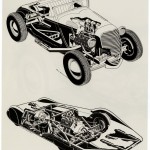Space engineering, at its peak during the space race, did not focus solely on the design of rockets and spaceships. Many of the actual marvels, meant to guarantee the ultimate survival of a man in space, are collected in a Smithsonian storage building in Washington.

Alan Shepard suit, Apollo 14 mission (1971)
Spacesuits, at their most basics, were designed to perform two nearly incompatible tasks: protect the body from the harshness of space environment while allowing the wearer to work and maneuver at his best.

The Smithsonian storage.

Test pilots in the 1960s showing off the flexibility of the lightweight Mark IV suits.
“When you pressurize it, it’s like working inside of a sausage,” said Dr. Joseph P. Kerwin, an astronaut aboard the Skylab mission in 1973. “The whole trick in designing a spacesuit was to make it easier to move the joints inside that inflated balloon.”
While the pressurization protect the astronaut, it easily prevents comfortable movements, because moving the joints of a bladder reduces the volume, increasing the pressure inside. Engineers, including Mr. Kosmo, spent years studying anatomy, movement and materials, in order to develop better joints.
The EX-1 model never made it to space, but was nevertheless a sort of milestone: its doughnut-shaped joints allowed for a balanced and constant pressure within the suit.
The collection includes the first models used in the Mercury program (1961 to 1963), which were simple variations of military high-altitude flight suits. They had only two layers — the pressure bladder and a nylon covering to protect the bladder and help it keep its rough shape when pressurized. Since the astronauts were crammed into the spaceship these early suits were not intented for mobility nor to be pressurized, unless an emergency, -such as loss of pressure- occurred, in which case the bladder could be inflated.
With the first spacewalks, the engineering of the suits should face obvious difficulties: the necessity for mobility within inflated bladder, resistance to possible punctures by high-speed micrometeoroids, overheating by sun. So more layers, of Dacron, Mylar and other polymer materials, were added to protect and insulate the astronaut, while other needs were discovered after use.
The Apollo 11 suits (among whom the one belonged to Neil Armstrong), increased the number of layers up to 20, including an outer one of Beta cloth, woven from Teflon-wrapped glass fibers: the suits had to be bulky, allow for movements and work, to be heat- and cold- proof (a new water cooling system was developed) and able to resist to all sorts of falling and ripping on the surface of the Moon.

Apollo 11’s Buzz Aldrin within his spacesuit












For more slides: go here.
Much of this post refers to the original NY Times article.





Leave a Reply